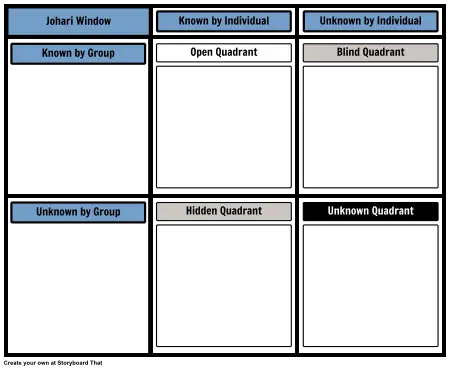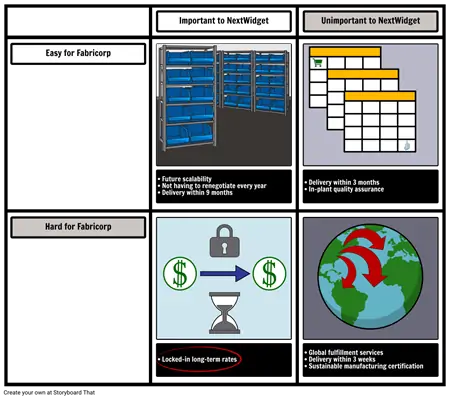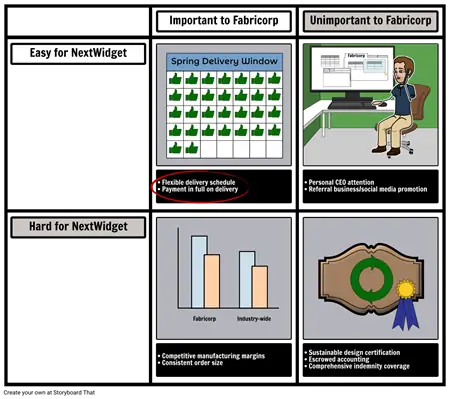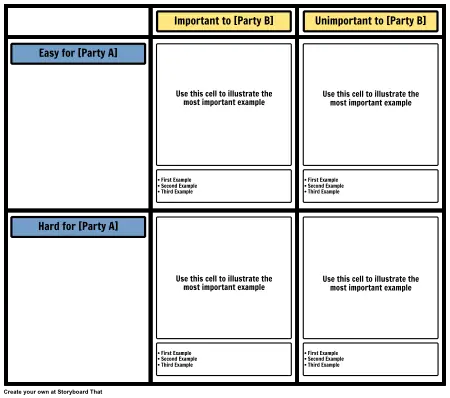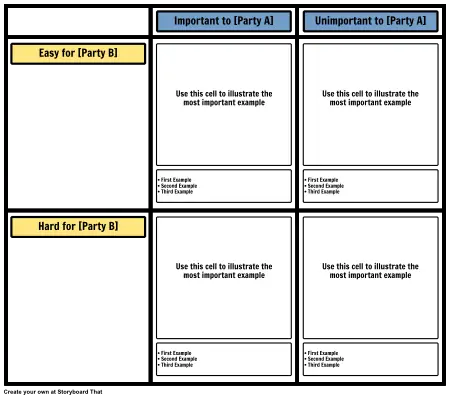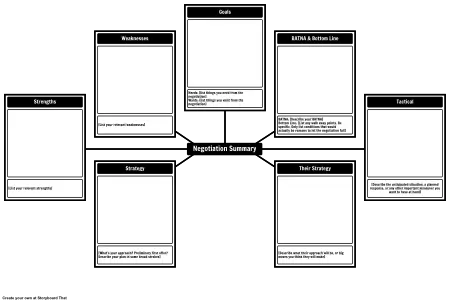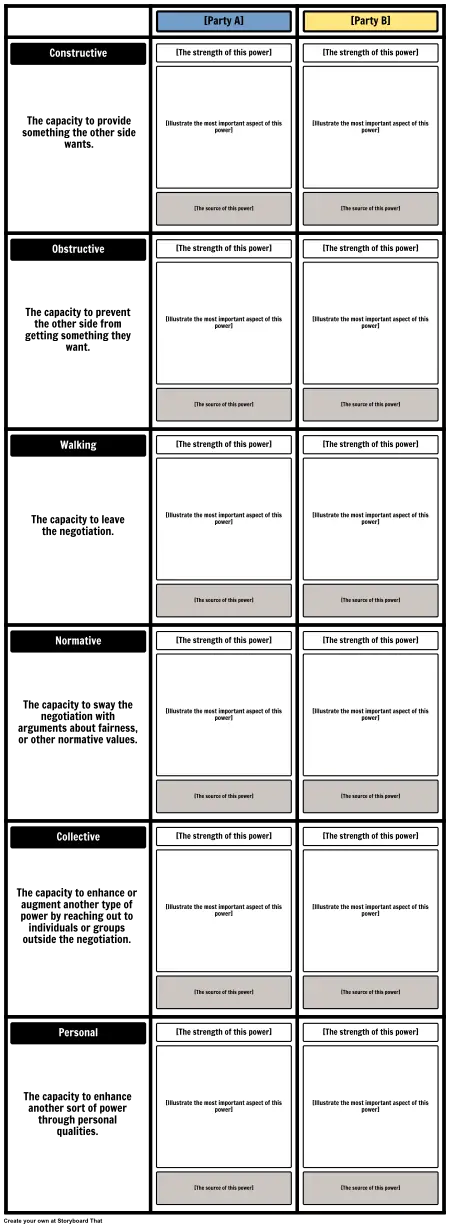Preparation is Key to Success
We frequently think that the best negotiators are those who are quick on their feet and ready to go at a moment’s notice. We imagine that the ability to negotiate is some innate capability that some people have, and other’s don’t. This couldn’t be further from the truth. The key to a successful negotiation is preparation. Lots of preparation. From background research, to concrete strategy and planning, time spent preparing to negotiate will pay off when you sit down at the table.
This guide lays out six steps you can take to prepare for your next negotiation, and how to use storyboards and graphic organizers to make that preparation both effective and efficient. You’ll find templates that you can use to help in your preparations, and examples to illustrate finished results.
All the examples follow the story of NextWidget, a smart-widget startup, as they prepare to renegotiate their contract with Fabricorp, their manufacturer.*
Step One: Before You Begin
Good preparation needs to rest on a strong foundation of knowledge. Before you even begin to plan a specific negotiation, you should take time to research and reflect on elements that will play an important role in it. What are some points you should be sure to focus on?
First: Know Thyself
You are a participant in every negotiation you enter. If you can be honest about yourself and your position, you can avoid many stumbling blocks of novice negotiators. Before beginning preparations for a specific negotiation, you should know:
Something about yourself and how others perceive you
A "Johari Window" is a simple exercise to record and expand self-knowledge. Self-reflection will yield dividends across a wide range of activities, and may be particularly helpful if you are negotiating as a team rather than as an individual.
Your preferred negotiation style
Are you cooperative negotiator? A competitive one? If you’re not familiar with negotiation styles, read up and reflect on how you feel most comfortable when negotiating. Think about some of your recent negotiations, and how you approached them.
Strengths and weaknesses of your position
A "SWOT analysis" is a great tool to get a realistic and balanced picture of where you stand.

Second: Know Your Enemy.
It isn’t enough to know where you are coming from, you should also know as much as you can about your opponent.
Imagine yourself in the position of your opponent.
Perform the same examination you have just undertaken for yourself, but from their perspective. If nothing else, organize the salient information you have about your opponent with a spider map, so that you can see it at a glance.
What do they want out of the negotiation?
Consider what the other side of this negotiation is looking to get from the negotiation. Be cautious not to jump to the conclusion that they want to nickle and dime you. Many times, “opponents” are potential collaborators, if your interests align sufficiently.
What is your relationship with the other side?
Are you familiar? What is the history? Consider making a timeline to organize this information. Trust is an important factor in negotiations and your history with the other side will be a big component of that.
Third: Know the Terrain.
If you’ve already done a SWOT analysis, you’ve begun to think about some of the environmental factors surrounding the negotiation. These can be further explored on a macro level with frameworks like Porter’s five forces, or a PEST analysis. Other things to research and consider include:
Who is watching this negotiation?
Even private negotiations have audiences. Negotiators on both sides may have stakeholders they are reporting back to, or competitors who will catch wind of the result. Some of the most important audience members are in the room, since every negotiator wants to be able to walk away from the table with a winning narrative.
What are some ground rules you want to have for the negotiation?
Are there any resources your opponent is likely to want? What issues are off topic or out of bounds?
Information about your industry
Any information about your field or industry can be helpful, and will likely be useful in the future anyway. You may not even think about this information during the negotiation, but it will help orient you and inform your preparations.
Use the templates below to make your own SWOT Analysis or Johari window.
Step Two: What Are Your Objectives?
An often neglected aspect of negotiation planning is to really consider what the objectives are. It is easy to lose perspective and jump to an obvious conclusion then pursue that objective throughout the negotiation. Hasty conclusions may not be as beneficial as they first appear, and may crowd out creative alternatives.
Consider what you need out of the negotiation, and what you want out of it. “Needs” are those objectives that are inflexible and will require you walking from the negotiation if you cannot get. They also include those things that you can’t do, either because it is out of your power, or it is not worthwhile. They form your bottom line and should not be conceded.
”Wants”, on the other hand, are objectives that can be traded away, or modified in some way. Even if they are valuable, not getting them will not make the negotiation unsuccessful. They should be traded away for “needs”. They also form fertile ground for creative collaborations, since they can change to accommodate the needs and wants of the other side.
Start by brainstorming things you’d like to result from this negotiation. Divide the results into “needs” and “wants”. Combine your “needs” into a bottom line, and see if there are any “wants” that are incompatible. Consider ranking the remaining “wants” by how valuable they are to you.
Step Three: BATNAs and Best First Offers
Since not all negotiations are successful, you should be ready to walk away from the table. You already know what you need from the negotiation, and have a bottom line, but you should be prepared with a Best Alternative to a Negotiated Agreement, or a “BATNA”. There are four steps in formulating a BATNA:
Generate by brainstorming a wide range of alternatives. Imagine that the negotiation has already failed, and think about what you would do. A spider map is perfect for this.
Develop some of the more promising ideas into a fleshed-out scenario with a Frayer Model or storyboards. Make sure to include important steps, results, and other salient details.
Evaluate each plan by looking at the likely outcomes and costs. If you can, compare the options across commensurate metrics using a grid.
Select the most promising of all the options. This is your best alternative to negotiated agreement, your BATNA.

In evaluating your alternatives, you may be able to use a number of very specific metrics, but even a very general analysis can be covered by dividing information into solid data, clear strengths, possible weaknesses, and other pertinent information. Illustrating the most salient point in each category will make the comparisons more striking.

BATNAs and Bottom Lines
If your BATNA is significantly better or worse than your walking point, you may want to reassess one or the other.
Now that you’ve thought about when you might walk away, consider when your opponent might do the same. What do they want? What do they need? What are their alternatives? Try to assess your opponent's goals, bottom line, and BATNA. Once you have done so, develop a tentative offer you could extend during the negotiation.
This first offer should be something they can agree to that satisfies all of your needs and as many of your wants as possible. As you get more information before and during the negotiation, you can modify this first offer before presenting it to the other side.
Step Four: Comparing the Parties' Positions
Comparing Styles & Approaches
What is your negotiation style? What is their style? What approaches
are the two sides likely to take? What is the outcome of them matching up?
Make a storyboard to envision the likely outcome. Consider adapting your style to suit the circumstances.
Comparing Power
People sometimes talk about being in a strong bargaining position. What does this really mean? A negotiationpower analysis will help you understand how advantageous your bargaining position really is and compare it to your opponent’s position.
Using a grid, list your power in each category and that of your opponent.
| Constructive | The ability to provide something the other side wants. For example: A buyer has constructive power to give a seller money, and the seller has constructive power to give the buyer the goods they seek. |
|---|---|
| Obstructive | The ability to keep the other side from getting something they want. An example would be threatening to boycott a company or product. |
| Walking | This is the freedom to walk away from a negotiation. It is increased by a strong BATNA. It is important not to use this power too forcefully; like obstructive power, it can erode trust. |
| Normative | Appealing to normative values like fairness is often overlooked as a negotiation tactic. However, it is a cornerstone of informal negotiations and compliments other powers well. It is especially important to negotiators who have very little to bargain with in the other power categories. |
| Collective | This is a capacity to enhance or augment another type of power by reaching out to individuals or groups outside the negotiation. It is the force behind union solidarity strikes; a company may be able to find replacements for their own workers, but still need deliveries by drivers who won’t cross picket lines. |
| Personal | This is the charisma or abilities of a specific negotiator to work with others, problem solve, or persuade. It allows the other form of power to be effectively deployed in competitive and collaborative negotiations. |

Finding Common Ground
What is important to you? What is important to them? What can you easily give? What can they easily give? This information can be conveniently arranged in a pair of 2x2 grids.
- The things that are easy for one side and important to the other are likely to be the focus of productive negotiations.
- The things that are unimportant and expensive are distractions.
- Unimportant but inexpensive items are bonuses, concessions each side can easily make as gestures of goodwill, or to balance out deals.
- Expensive but important items are difficult to agree on and may threaten to derail the negotiation.
Use this information to look for common ground. Goals that are important to both sides and compatible are excellent starting points for a mutually beneficial agreement. Expect progress to be made quickly in these areas, and pave the way for more contentious items.
These comparisons are also useful in constructing bargaining packages, which we’ll discuss more in the next step.
Step Five: Imagining Negotiations
When bargaining, it is tempting to tackle one issue at a time. Sometimes it is strategically important to establish one point of agreement before moving on to others, but often this misses the forest for the trees. The alternative is to group many items into a “package”. This can soften the reception to undesirable points, and keeps outcomes from becoming incoherent or contradictory.
Bargaining with packages rather than item by item does create complex offers and counteroffers though, which can be harder to keep straight. It is helpful to imagine these in a concrete way, rather than as a list of discrete items. A storyboard or graphic organizer can tie these elements together.
Principled negotiation
has many of these same complications. Since the parties are not simply pushing each other towards a bottom line, the deals become collaborative, creative, and potentially complex.
Storyboard negotiations or outcomes can be of particular use during preparation:
As a narrative for yourself.
Storyboarding provides an opportunity to anticipate and rehearse the negotiation, as a whole or in individual moments.
For selling your offer.
If you can paint a vivid picture of what your offer will mean to the other side, it can help them understand how your suggestion will be beneficial.
When communicating to your team or stakeholders.
Suggestions in negotiation can seem abstract and unclear. A storyboard of a decision or outcome keeps everyone on the same page.

Step Six: Organize
The final step in preparation is take all the information you have just generated and put it in one place. Isolating the vital aspects of your plan and combining them will keep you on track and help you quickly adapt as the negotiation progresses.
What are your goals?Don’t lose sight of what you want and need from the negotiation. This may be one specific thing, or a few related items. Try to focus on essentials here, rather than listing every possible point of negotiation. |
Where are you strong? Where are you weak?Remember your SWOT analysis from the beginning, and the power comparison from Step Four. Try to steer the negotiation so you can take advantage of your strengths and minimize your weaknesses. |
What is your best alternative?Have your BATNA and bottom line at hand to remind you of when to think about walking away. |
What is your strategy?This is the big picture, including your negotiation approach, preliminary first offer, and other parts of your plan that aren’t directly related to the actions of the other side. |
What is their strategy?Again, broad strokes here. What do you expect their approach to be in the negotiation? How open are they to collaboration and compromise? |
What are your tactical options?In your planning, you’ve probably anticipated that certain points or proposals are going to be both inevitable and difficult to deal with. Draft some preplanned responses that you can execute when these crop up. |

Many of these steps inform each other, so you may find it easier to perform them in a different order, or to return to various steps as you proceed. If time or resources are a limiting factor, a brief look at each step will be better than nothing; even a little preparation goes a long way.
Remember, even the most comprehensive plan is unlikely to survive the opening of a negotiation, there are simply too many unknowns. The best you can do is prepare and be ready to adjust as the negotiation goes forward. A good plan positions you well to make the required adjustments, and to recover if you are caught off-guard.
Further Reading
This guide is drawn from a wide variety of sources. The Harvard Business Review has a number of excellent "articles on negotiation". We also recommend the books Getting to Yes by William Ury and Robert Fisher, its sequel, Getting Past No, also by William Ury, and G. Richard Shell’s Bargaining for Advantage.
And check out other Storyboard That articles about negotiation, management, and product development.
Use Our Templates
Throughout this article we have used a lot of different frameworks and templates. Here are all of the templates for you to easily create your own negotiation graphic organizers. These templates make it easy for you to plan how to negotiate.
*Disclaimer: The situations, entities, and people used as examples in this article are completely fictitious. Any resemblance to actual persons or entities is purely coincidental.
How Tos about How to Prepare for a Negotiation
How to teach negotiation skills using role-play activities in your classroom
Role-play activities are a dynamic way to introduce students to negotiation skills. Divide your class into pairs or small groups, assign each group a negotiation scenario, and let them act out both sides. Encourage students to use research, develop objectives, and consider their BATNAs before engaging. After the role-play, facilitate a reflection discussion to analyze strategies and outcomes. This hands-on approach makes negotiation concepts memorable and practical for students.
Set clear negotiation goals for your students
Ask each student or team to define what they want to achieve in their role-play negotiation. Have them write down their needs and wants before starting. This helps students stay focused and improves their negotiation planning skills.
Assign roles and background information
Hand out character profiles or scenario cards with relevant background details for each side. Include basic facts and objectives to give students context and help them empathize with their assigned role during the negotiation.
Encourage use of graphic organizers
Provide SWOT analysis templates and spider maps so students can visually organize their positions and strategies. This makes their preparation concrete and helps them see strengths, weaknesses, and possible alternatives before negotiating.
Debrief and reflect on negotiation outcomes
After each role-play, lead a class discussion about what strategies worked, what challenges arose, and how objectives were met or compromised. Encourage students to share insights and connect the activity to real-life negotiation situations.
Frequently Asked Questions about How to Prepare for a Negotiation
What are the best steps to prepare for a successful negotiation?
Successful negotiation preparation involves researching all parties, clarifying objectives, developing a BATNA (Best Alternative to a Negotiated Agreement), comparing positions, imagining possible outcomes, and organizing your strategy using graphic organizers or templates.
How can storyboards and graphic organizers help with negotiation planning?
Storyboards and graphic organizers make complex negotiation plans visual and clear, helping you anticipate scenarios, organize information about both sides, and communicate strategies effectively with your team or stakeholders.
What is a BATNA and why is it important in negotiations?
A BATNA (Best Alternative to a Negotiated Agreement) is your backup plan if the negotiation fails. Knowing your BATNA strengthens your position and helps you confidently decide when to walk away from the table.
How do I identify my needs versus wants when planning a negotiation?
Start by brainstorming everything you hope to gain. Classify non-negotiable items as needs (your bottom line), and flexible items as wants. Needs should guide your strategy, while wants can be traded for concessions.
What are key frameworks for analyzing negotiation strengths and weaknesses?
Use tools like SWOT analysis to assess strengths, weaknesses, opportunities, and threats. Frameworks such as Porter's Five Forces and PEST analysis help evaluate industry and environmental factors affecting your negotiation.
- flowchart • Sean MacEntee • License Attribution (http://creativecommons.org/licenses/by/2.0/)
© 2025 - Clever Prototypes, LLC - All rights reserved.
StoryboardThat is a trademark of Clever Prototypes, LLC, and Registered in U.S. Patent and Trademark Office

